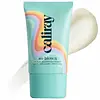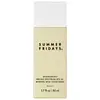What's inside
What's inside
 Key Ingredients
Key Ingredients

 Benefits
Benefits

 Concerns
Concerns

 Ingredients Side-by-side
Ingredients Side-by-side

Caprylyl Methicone
Skin ConditioningWater
Skin ConditioningPEG-12 Dimethicone/PPG-20 Crosspolymer
Disiloxane
Skin ConditioningPolysilicone-11
Isodecyl Neopentanoate
EmollientTripeptide-29
Skin ConditioningAdipic Acid/Neopentyl Glycol Crosspolymer
Hdi/Trimethylol Hexyllactone Crosspolymer
Niacinamide
SmoothingCaprylic/Capric Triglyceride
MaskingTocopherol
AntioxidantTocopheryl Acetate
AntioxidantCamellia Oleifera Seed Oil
Skin ConditioningSodium Acrylate/Sodium Acryloyldimethyl Taurate Copolymer
Emulsion StabilisingIsohexadecane
EmollientPolysorbate 80
EmulsifyingLaureth-12
EmulsifyingSorbitan Oleate
EmulsifyingLeuconostoc/Radish Root Ferment Filtrate
AntimicrobialSilica
AbrasivePistacia Lentiscus Gum
MaskingHydrogenated Lecithin
EmulsifyingPhenethyl Alcohol
MaskingPhenoxyethanol
PreservativeEthylhexylglycerin
Skin ConditioningCitrus Aurantium Dulcis Oil
MaskingCitronellol
PerfumingGeraniol
PerfumingFarnesol
PerfumingLimonene
PerfumingLinalool
PerfumingCitral
PerfumingCaprylyl Methicone, Water, PEG-12 Dimethicone/PPG-20 Crosspolymer, Disiloxane, Polysilicone-11, Isodecyl Neopentanoate, Tripeptide-29, Adipic Acid/Neopentyl Glycol Crosspolymer, Hdi/Trimethylol Hexyllactone Crosspolymer, Niacinamide, Caprylic/Capric Triglyceride, Tocopherol, Tocopheryl Acetate, Camellia Oleifera Seed Oil, Sodium Acrylate/Sodium Acryloyldimethyl Taurate Copolymer, Isohexadecane, Polysorbate 80, Laureth-12, Sorbitan Oleate, Leuconostoc/Radish Root Ferment Filtrate, Silica, Pistacia Lentiscus Gum, Hydrogenated Lecithin, Phenethyl Alcohol, Phenoxyethanol, Ethylhexylglycerin, Citrus Aurantium Dulcis Oil, Citronellol, Geraniol, Farnesol, Limonene, Linalool, Citral
Zinc Oxide 9.4%
Cosmetic ColorantWater
Skin ConditioningC12-15 Alkyl Benzoate
AntimicrobialSorbitan Oleate Decylglucoside Crosspolymer
CleansingArgania Spinosa Kernel Oil
EmollientTocopheryl Acetate
AntioxidantAmmonium Acryloyldimethyltaurate/Vp Copolymer
Glycerin
HumectantCaramel
Cosmetic ColorantPolyester-5
Squalane
EmollientButyrospermum Parkii Butter Extract
Skin ConditioningBisabolol
MaskingPhospholipids
Skin ConditioningTocopherol
AntioxidantEthyl Ferulate
AntioxidantUrea
BufferingEthylhexylglycerin
Skin ConditioningGluconolactone
Skin ConditioningTriethoxycaprylylsilane
Dimethicone
EmollientSodium Chloride
MaskingBenzyl Alcohol
PerfumingSodium Benzoate
MaskingSorbic Acid
PreservativeChlorphenesin
AntimicrobialPhenoxyethanol
PreservativeZinc Oxide 9.4%, Water, C12-15 Alkyl Benzoate, Sorbitan Oleate Decylglucoside Crosspolymer, Argania Spinosa Kernel Oil, Tocopheryl Acetate, Ammonium Acryloyldimethyltaurate/Vp Copolymer, Glycerin, Caramel, Polyester-5, Squalane, Butyrospermum Parkii Butter Extract, Bisabolol, Phospholipids, Tocopherol, Ethyl Ferulate, Urea, Ethylhexylglycerin, Gluconolactone, Triethoxycaprylylsilane, Dimethicone, Sodium Chloride, Benzyl Alcohol, Sodium Benzoate, Sorbic Acid, Chlorphenesin, Phenoxyethanol
 Reviews
Reviews

Alternatives
Ingredients Explained
These ingredients are found in both products.
Ingredients higher up in an ingredient list are typically present in a larger amount.
Ethylhexylglycerin (we can't pronounce this either) is commonly used as a preservative and skin softener. It is derived from glyceryl.
You might see Ethylhexylglycerin often paired with other preservatives such as phenoxyethanol. Ethylhexylglycerin has been found to increase the effectiveness of these other preservatives.
Phenoxyethanol is a preservative that has germicide, antimicrobial, and aromatic properties. Studies show that phenoxyethanol can prevent microbial growth. By itself, it has a scent that is similar to that of a rose.
It's often used in formulations along with Caprylyl Glycol to preserve the shelf life of products.
Tocopherol (also known as Vitamin E) is a common antioxidant used to help protect the skin from free-radicals and strengthen the skin barrier. It's also fat soluble - this means our skin is great at absorbing it.
Vitamin E also helps keep your natural skin lipids healthy. Your lipid skin barrier naturally consists of lipids, ceramides, and fatty acids. Vitamin E offers extra protection for your skin’s lipid barrier, keeping your skin healthy and nourished.
Another benefit is a bit of UV protection. Vitamin E helps reduce the damage caused by UVB rays. (It should not replace your sunscreen). Combining it with Vitamin C can decrease sunburned cells and hyperpigmentation after UV exposure.
You might have noticed Vitamin E + C often paired together. This is because it is great at stabilizing Vitamin C. Using the two together helps increase the effectiveness of both ingredients.
There are often claims that Vitamin E can reduce/prevent scarring, but these claims haven't been confirmed by scientific research.
Learn more about TocopherolTocopheryl Acetate is AKA Vitamin E. It is an antioxidant and protects your skin from free radicals. Free radicals damage the skin by breaking down collagen.
One study found using Tocopheryl Acetate with Vitamin C decreased the number of sunburned cells.
Tocopheryl Acetate is commonly found in both skincare and dietary supplements.
Learn more about Tocopheryl AcetateWater. It's the most common cosmetic ingredient of all. You'll usually see it at the top of ingredient lists, meaning that it makes up the largest part of the product.
So why is it so popular? Water most often acts as a solvent - this means that it helps dissolve other ingredients into the formulation.
You'll also recognize water as that liquid we all need to stay alive. If you see this, drink a glass of water. Stay hydrated!
Learn more about Water